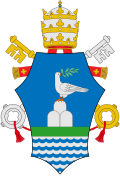Content
The encyclical centres on Christ fully human and fully divine, as defined by the council of Chalcedon in the year 451. Two points were important at that council of Chalcedon according to Pius XII: first, the principal role of the Roman Pontiff in such an essential theological debate; and second, the importance of the dogma itself. In light of the many persecutions and open hostility to everything Christian, Pope Pius appeals to all separated Christians to look again at Chalcedon and rethink their view of the Roman papacy. In light of the dogma of Christ fully divine and human, he refers to those, who have still problems with this article of faith. [2]
The encyclical reviews the history of the council and the events leading to it, describing the illegal synod at Ephesus, the role of Flavian and the interventions of Pope Leo the Great. In Chalcedon, the priority of the Apostolic See was clarified, when it was pronounced "Peter spoke through the mouth of Leo". Pope Pius XII also credits the council with clear language using concepts without any double meaning. [3]
The Pontiff uses the occasion of the anniversary to clarify the faith in light of some contemporary views of Christ, which in the Catholic view are heresies. Especially, tendencies to view Christ as mainly human or spiritual are wrong even if they claim to relate to Chalcedon. The Pope concludes his encyclical with an urgent call to the Eastern Christians not in communion with the Catholic Church to join the Catholic Church. The encyclical adds that the enemies of Christianity are so numerous, that only a common belief and joint effort seem to be promising. [4]
This page is based on this
Wikipedia article Text is available under the
CC BY-SA 4.0 license; additional terms may apply.
Images, videos and audio are available under their respective licenses.

